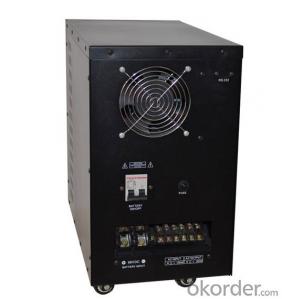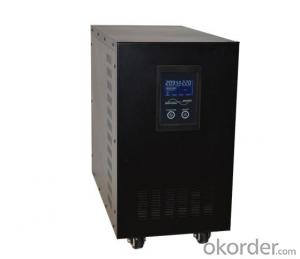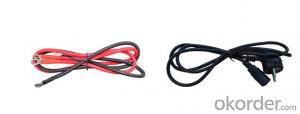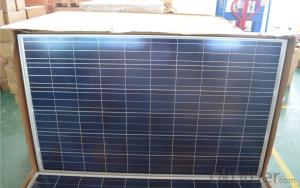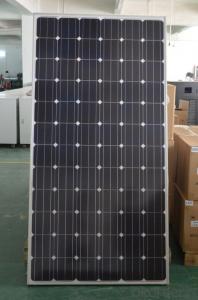Solar energy system 1000W to 5000W for home use
- Loading Port:
- Guangzhou
- Payment Terms:
- TT OR LC
- Min Order Qty:
- 1 set
- Supply Capability:
- 1000 set/month
OKorder Service Pledge
OKorder Financial Service
You Might Also Like
Solar energy system 1000W to 5000W for home use
Features
Solar cell modules
It converts solar energy into electrical energy and the frames support solar panels.
Charge controller
It supplies direct current regulated from solar modules to the battery or inverter.
Stand-Alone Inverter
It supplies alternative current to loads after rectifying the direct current.
Battery
It supplies the electric power to loads through inverter in case the electric power generated from solar modules is in short supply or at night.
Complete 24V/1000W stand alone solar systems
5×200w poly solar panels//1×24V/50A solar charge controller//1×48V/3000W pure sine wave
inverter//4×12V/200Ah lead acid batteries//ground mounting brackets//50m PV cables for solar
panels connection//dual connectors for solar panels connection//connection cables for batteries.
average produce 6kwh power each day!!!
| 12V/200W Poly-crystalline Solar Panels | ||||||||
| Model: 200P Maximum power:200W Maximum power voltage:35V Maximum power current:5.71A Open circuit voltage:42.48V Short circuit current:6.29A Dimension:1350mm×1000mm×45mm Weight: 17.5kg Solar cells:48pieces(6×8)poly solar cells156mm×156mm;Grade A; CE certification Maximum systems voltage: 1000V |  | |||||||
Wiring of solar panels: 1 panels in series, 5 strings in parallel | ||||||||
| 24V/50A solar charge controller | ||||||||
| Model:2450 Rated voltage: 24V Rated current: 50A Over-voltage protection 34V Over-discharge recover voltage: 25V working temperature: -20℃~45℃ Dimension: 184mm×110mm×57mm Weight: 0.66kg Features: battery switch | 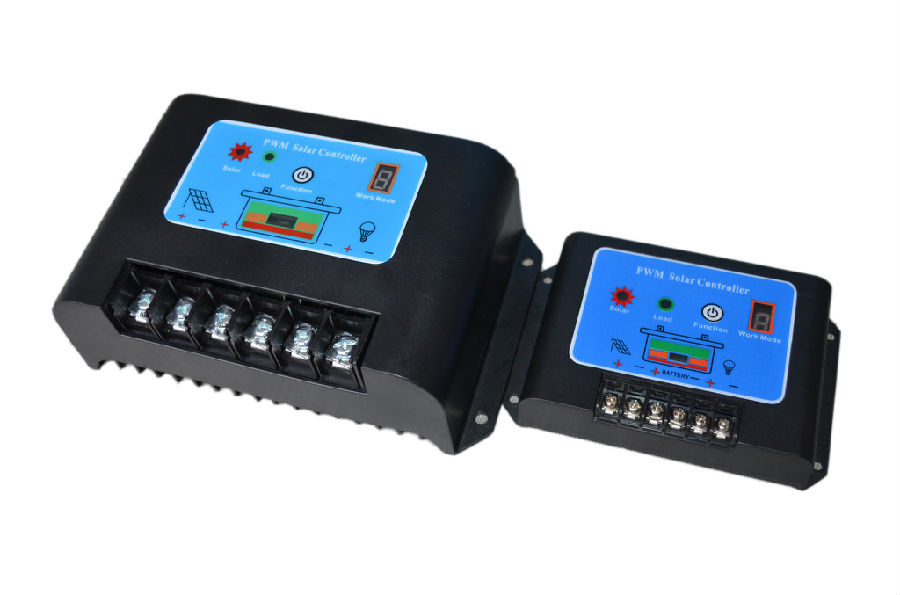 | |||||||
| Wiring of solar charge controller: firstly connect solar charge controller with battery bank, then connect solar charge controller with solar panels array, at last connect solar charge controller with loads or pure sine wave inverter | ||||||||
| 48V/3000W Pure Sine Wave Inverter | ||||||||
| Model:10224 Rated input voltage:DC24V Input voltage range:75V~125V OR 145V~275V Output voltage:AC210V~AC240V Rated output power:1000W Maximum output power:2000W Output wave form: pure sine wave Dimension:396mm×190mm×240mm Weight:14kg. Working temperature: 0℃~40℃. Battery low voltage shutdown: DC21V | 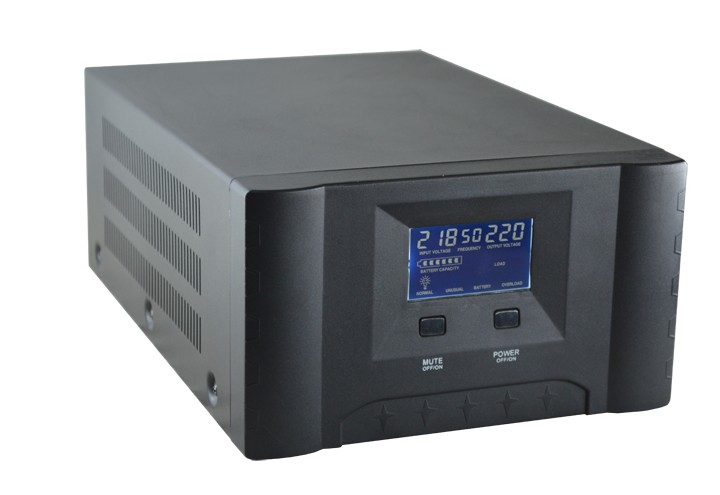 | |||||||
| 12V/200Ah deep cycle battery | ||||||||
| Deep cycle batteries in our stand alone solar systems have 2000 time charging-discharging cycle at 50% DOD. Gel batteries have better performance than lead acid batteries under cold temperature. besides, these battery are free-maintenance. |
| Package&shipment terms | |||||||||
| 1,We would pack all components into one plywood case and put much foam inside of plywood case, this packing way can make all components stand long distance transportation. 2,Because batteries are a kind of very heavy components and can't be allowed to transport by air, we have to choose sea transportation. though sea transportation would take more days to arrive, however you can save much postage. 3.We would ship the system to any bigger port near to customers, customers need to go to the port and pick up the system. |
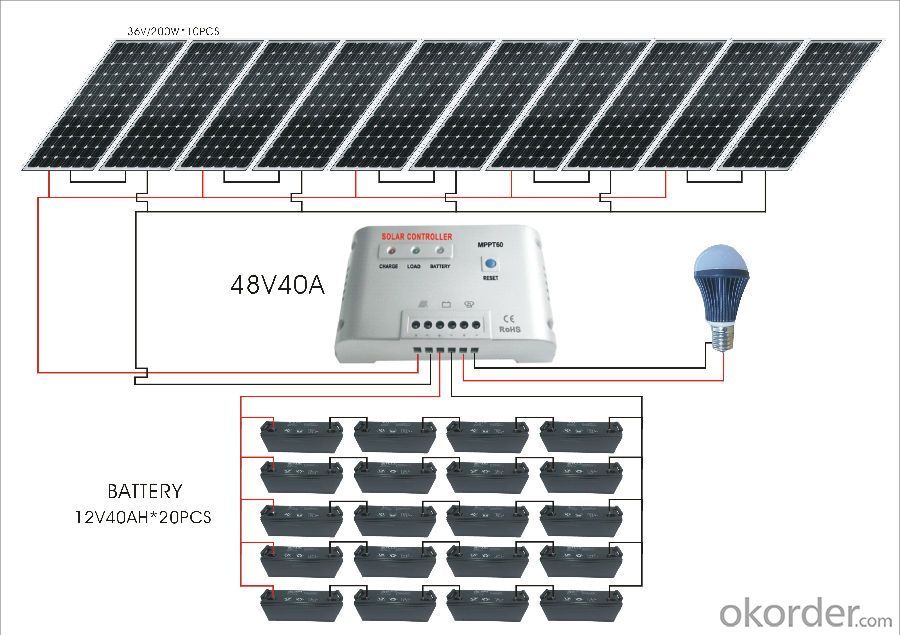
More power system pls contact with me!
- Q:Can solar energy systems be used for powering remote sensing devices?
- Yes, solar energy systems can definitely be used for powering remote sensing devices. Solar power is an excellent source of energy for remote locations where access to traditional power grids is limited or non-existent. Remote sensing devices, such as weather stations, surveillance cameras, tracking systems, or environmental monitoring instruments, require a steady and reliable power supply to function effectively. Solar energy systems, such as solar panels or photovoltaic (PV) cells, can convert sunlight directly into electricity. These systems can be installed in remote areas to harness solar energy and provide a sustainable and renewable power source for remote sensing devices. Solar panels are typically made of semiconductor materials that absorb sunlight and generate direct current (DC) electricity. This electricity can either be used immediately to power the sensing devices or stored in batteries for later use during periods of low sunlight or at night. Using solar energy systems for powering remote sensing devices has several advantages. Firstly, solar power is abundant and available in most parts of the world, making it highly suitable for remote locations where other power sources may not be feasible. Secondly, solar energy is clean and renewable, reducing the reliance on fossil fuels and minimizing environmental impact. Additionally, solar power systems are low maintenance and have a long lifespan, making them cost-effective and reliable for powering remote sensing devices. In conclusion, solar energy systems are a practical and sustainable solution for powering remote sensing devices. They provide a reliable and renewable energy source, enabling remote sensing devices to operate efficiently in remote and off-grid locations.
- Q:Can solar energy be used during power outages?
- Indeed, the utilization of solar energy is possible in situations of power outages. Solar panels, also referred to as photovoltaic (PV) systems, have the capability to convert sunlight into electricity. By connecting these panels to a storage battery system, any surplus solar energy can be stored and utilized when sunlight is not accessible, such as during power failures. These battery systems serve as dependable sources of electricity, ensuring the continuity of essential appliances and devices even when the main power supply is disrupted. Furthermore, solar-powered generators can also be employed temporarily during power outages to provide an alternative source of electricity. In summary, solar energy systems present a trustworthy and sustainable solution to power outages, enabling the provision of electricity even in instances of traditional power grid failures.
- Q:Can solar energy systems be used in powering outdoor signage or billboards?
- Indeed, outdoor signage or billboards can be powered by solar energy systems. By placing solar panels on the roof or nearby structures, sunlight can be captured and transformed into electricity. This generated electricity is then employed to illuminate the lights or operate the digital displays of the signage or billboards, enabling them to function autonomously without relying on the conventional power grid. Given their prevalence in sun-drenched areas, solar energy systems are especially well-suited for outdoor signage. Moreover, utilizing solar energy aids in mitigating the carbon footprint linked to traditional methods of electricity production, rendering it an eco-friendly alternative.
- Q:Can solar energy systems be used for powering electric vehicle car-sharing programs?
- Yes, solar energy systems can be used for powering electric vehicle car-sharing programs. Solar panels can be installed on the rooftops of car-sharing stations or nearby buildings to generate clean and renewable energy. The energy harvested from these solar panels can then be used to charge the electric vehicles in the car-sharing program. By utilizing solar energy, car-sharing programs can significantly reduce their carbon footprint and reliance on fossil fuels. Additionally, solar-powered car-sharing programs can benefit from lower operating costs as they are not dependent on electricity from the grid, which can be expensive and subject to price fluctuations. Overall, integrating solar energy systems into electric vehicle car-sharing programs is a sustainable and environmentally friendly solution.
- Q:Can solar energy systems be used in areas with limited access to the electrical grid?
- Yes, solar energy systems can definitely be used in areas with limited access to the electrical grid. In fact, solar power is an ideal solution for such areas as it offers a decentralized and sustainable source of electricity. Solar energy systems, such as photovoltaic panels, harness the energy from the sun and convert it into usable electricity. These systems can be installed in remote locations without the need for extensive electrical infrastructure. By utilizing solar energy systems, areas with limited access to the electrical grid can become self-sufficient in meeting their energy needs. These systems can power essential appliances, such as lighting, communication devices, and small-scale machinery, providing reliable energy even in areas where traditional grid connections are not available or unreliable. Moreover, solar energy systems can bring numerous benefits to areas with limited grid access. They offer an environmentally friendly alternative to traditional fossil fuel-dependent energy sources, thereby reducing carbon emissions and combating climate change. Solar power systems also provide a reliable and consistent source of energy, reducing the dependence on diesel generators or other costly and polluting forms of energy. Additionally, solar energy can promote economic growth and development in remote areas. By powering essential infrastructure like schools, hospitals, and businesses, solar systems can improve education, healthcare, and economic opportunities. Moreover, the installation and maintenance of solar energy systems can create local jobs and foster entrepreneurship. To ensure the successful implementation of solar energy systems in areas with limited grid access, it is crucial to address challenges such as initial costs, technical expertise, and maintenance. However, with advancements in technology and decreasing costs, solar power has become increasingly accessible and affordable. Various organizations, governments, and non-profit entities are actively working to promote solar energy adoption in such areas and provide necessary assistance. In conclusion, solar energy systems are a viable and sustainable solution for areas with limited access to the electrical grid. They offer a decentralized, reliable, and environmentally friendly source of electricity, bringing numerous benefits to these regions. By harnessing the power of the sun, these systems can empower communities, promote economic development, and improve the quality of life for those living in remote areas.
- Q:What is the role of solar energy systems in promoting sustainability?
- Solar energy systems play a crucial role in promoting sustainability by harnessing the abundant and renewable energy from the sun. By generating electricity without relying on fossil fuels, solar power helps reduce greenhouse gas emissions and mitigate climate change. Additionally, solar energy systems contribute to energy independence, as they can be deployed on rooftops or in remote areas, reducing the need for long-distance transmission lines. Moreover, solar power has economic benefits, creating jobs and stimulating local economies. Overall, solar energy systems are a key component in transitioning to a more sustainable and clean energy future.
- Q:Do solar energy systems require batteries?
- No, solar energy systems do not necessarily require batteries.
- Q:Can solar energy systems be used in powering amusement parks?
- Certainly, amusement parks can utilize solar energy systems to power their operations. In recent years, solar power has gained popularity due to its numerous advantages. The energy requirements of amusement parks are substantial, as they need power for rides, lighting, and other facilities. By incorporating solar energy systems, parks can decrease their reliance on conventional energy sources and significantly reduce operational expenses. To harness the sun's power, solar panels can be installed on amusement park rooftops, parking lots, or open areas. These panels convert sunlight into electricity, which can be directly used to power various park activities. Moreover, any excess energy produced during peak sunlight hours can be stored in batteries for use during cloudy or nighttime conditions. The benefits of employing solar energy in amusement parks are extensive. Firstly, solar energy is a renewable and sustainable source, which means it does not deplete natural resources or emit harmful substances. This makes solar energy an environmentally friendly choice that aligns with the growing focus on green initiatives and carbon footprint reduction. Furthermore, solar energy systems offer a stable and predictable power source. Amusement parks often experience high energy demands during busy periods, such as weekends or holidays. Solar panels can easily handle these fluctuations and ensure a consistent power supply, minimizing the risk of power outages or interruptions. Additionally, the installation of solar panels can enhance the overall image and brand of an amusement park. By showcasing a commitment to sustainable practices, parks can attract environmentally conscious visitors and differentiate themselves from competitors. This can contribute to a positive public perception and potentially increase visitor numbers. In conclusion, solar energy systems are undeniably suitable for powering amusement parks. Their ability to generate clean, reliable, and cost-effective electricity makes them an ideal solution for meeting the energy requirements of amusement parks. By harnessing the sun's power, parks can reduce their carbon footprint, decrease operational costs, and enhance their overall appeal to visitors.
- Q:What is a solar battery?
- A solar battery, known by other names such as a solar energy storage system or solar storage battery, functions as a device that stores electrical energy generated by solar panels for later use. It is a vital component in solar power systems as it enables the storage and utilization of excess electricity produced during the day when there is little or no sunlight, such as at night or on cloudy days. To elaborate on how solar batteries work, they convert the direct current (DC) electricity generated by solar panels into alternating current (AC) electricity, which can be used to power various household appliances and devices. This conversion occurs by storing the energy in chemical form, commonly utilizing rechargeable batteries like lithium-ion or lead-acid batteries. The stored energy can be accessed at any time, ensuring a consistent and uninterrupted supply of electricity even when sunlight is not present. This aspect is especially advantageous for residential and commercial applications, as it reduces dependence on the grid and provides greater energy independence. In addition to acting as a backup power source, solar batteries optimize the use of solar energy. They achieve this by storing excess electricity during high production periods and discharging it during high demand periods. This approach maximizes the self-consumption of solar energy and minimizes reliance on the grid, resulting in significant cost savings and improved efficiency for owners of solar power systems. All in all, solar batteries play a pivotal role in facilitating the efficient and reliable utilization of solar energy. They offer a sustainable and environmentally friendly means of storing and using solar power, contributing to the expansion of renewable energy and decreasing reliance on fossil fuels.
- Q:Can solar energy systems be used in areas with limited access to maintenance services?
- Yes, solar energy systems can be used in areas with limited access to maintenance services. Solar panels are relatively low-maintenance and durable, requiring minimal upkeep. They do not have moving parts that can wear out, and regular cleaning is often the only maintenance required. Additionally, advancements in technology have made solar systems more reliable and efficient, reducing the need for frequent maintenance.
1. Manufacturer Overview |
|
|---|---|
| Location | |
| Year Established | |
| Annual Output Value | |
| Main Markets | |
| Company Certifications | |
2. Manufacturer Certificates |
|
|---|---|
| a) Certification Name | |
| Range | |
| Reference | |
| Validity Period | |
3. Manufacturer Capability |
|
|---|---|
| a)Trade Capacity | |
| Nearest Port | |
| Export Percentage | |
| No.of Employees in Trade Department | |
| Language Spoken: | |
| b)Factory Information | |
| Factory Size: | |
| No. of Production Lines | |
| Contract Manufacturing | |
| Product Price Range | |
Send your message to us
Solar energy system 1000W to 5000W for home use
- Loading Port:
- Guangzhou
- Payment Terms:
- TT OR LC
- Min Order Qty:
- 1 set
- Supply Capability:
- 1000 set/month
OKorder Service Pledge
OKorder Financial Service
Similar products
New products
Hot products
Hot Searches
Related keywords

